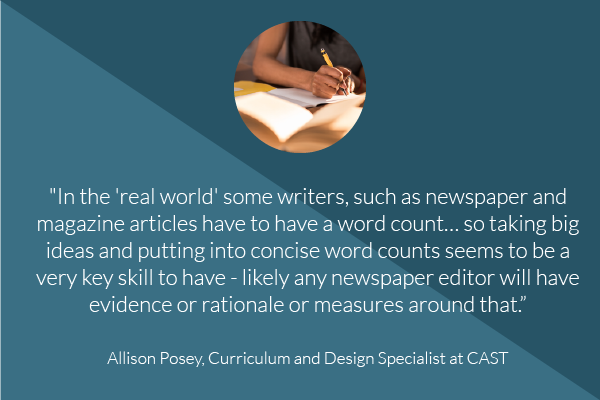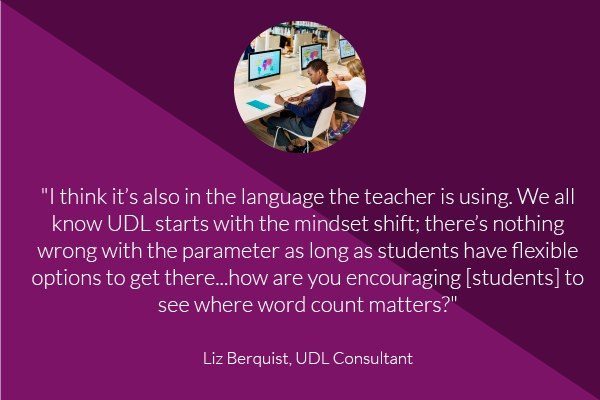The question may seem like a simple one on the surface: How does asking students to write using word counts or paragraph numbers as success criteria support expert learning through the UDL framework?
When my colleague, Joni Degner, recently forwarded an email posing this question, it gave me pause. Why do we so regularly impose writing limits on students? 1000 words. 5 paragraphs. 3000 characters. She wanted fellow UDL experts to weigh in, and we did. For starters, none of us found any research that supported the idea of using word counts or other writing limitations when assigning lessons. But did that mean that writing limits aren’t good for our students?
Allison Posey, Curriculum and Design Specialist at CAST, reframed the question: “How does writing with word counts or paragraph number build to expert writing?” Expert learning – the end goal of Universal Design for Learning – is, after all, what we are all working so hard to promote and achieve.

“In the ‘real world’ some writers, such as newspaper and magazine contributors have to have a word count… so taking big ideas and putting into concise word counts seems to be a very key skill to have – likely any newspaper editor will have evidence or rationale or measures around that,” stated Posey.
I agreed with Allison that word count is actually an authentic skill – I have to write within a specific word count all the time, as I often submit articles to journals and publications. For example, I recently wrote an article for ASCD and they told me it had to be between 700-750 words. Non-negotiable.
One might think since many publications are now online (and often, exclusively), the word count wouldn’t matter anymore, but turns out, it does. Publications – online or otherwise – do regular market research on their readership to determine which articles get the most interaction. They know what works for their readers, and what doesn’t. So why does word count matter, when does it matter, and what is the magical “correct length” when we do impose a limit?
Some could argue that adding in a word count into an assignment might shift the focus of the lesson in the wrong direction. “The word count or length parameter shifts the goal of writing from being internal (do a good job on my paper and cover the topic) to external (meet the word count). Experts and practitioners in UDL would be more likely to advocate for a more flexible range in the length, and many would advocate for none at all,” said Joni.

Yet, can we ignore the environment in which our students will one day work? The answer – for me at least – is that the best word count (or a word count at all) depends on task, purpose, and audience. Sometimes, length will matter – like in a college essay or an AP exam. It’s required because the task and the audience require it. Other times, it doesn’t matter and the student should be involved in the cognitive struggle to determine how long they need it to be based on the task, purpose, and audience. This promotes critical thinking and problem solving – two necessary skills of expert learners. But the ability to communicate in a concise and clear manner – especially when provided with a limit – is also a skill that requires critical thinking and problem solving.
Liz Berquist, another UDL advocate, added, “I think it’s also in the language the teacher is using. We all know UDL starts with the mindset shift; there’s nothing wrong with the parameter as long as students have flexible options to get there…how are you encouraging [students] to see where word count matters?”

Mindy Johnson, Director of Digital Communications & Outreach at CAST weighed in with one of the most widespread examples of writing limits: Twitter. With Twitter, you need to say something meaningful with 280 characters (an increase over the previous 140 character limit). If students want their peers to listen, they have to say something others want to hear or they will be drowned out by those who are more interesting. Despite the recent increase in character limit on Twitter, Mindy noted that most tweets still fall below 140 characters. Brevity packs a punch and it’s worthwhile for students to learn that skill for when it is necessary to use.
“It’s pretty amazing what you can fit within that constraint when there’s flexibility in how you can use those characters (images, GIFs, emojis, videos, hashtags, hyperlinks to more info, etc.). How cool would it be to use [the Twitter character limit] constraint as a scaffold? At the beginning of the year, we’re composing tweets. By the end, we’re creating 750-1000 word compositions that are authentic, meaningful, and serve a purpose (and are tied to examples of why you might choose one length over another),” suggested Mindy.

But teachers must be careful to remove barriers and provide supports to students, whether they impose a writing limit or not. “The short answer for me is that a parameter doesn’t provide support. It’s the instruction, scaffolds, exemplars, checklists, planning tools, access to multiple tools, and mastery-oriented feedback that support expert learning in writing,” said Joni.
“A parameter around length has the potential to communicate that what we value in writing is verbiage over concise, effective communication. If I’m a learner assigned to write a 1000 word essay, and I come to the end of my essay and come up with 855 words, there’s a very good chance that I’m going to pad the essay by adding unnecessary words that cloud the meaning. The parameter becomes pretty double-edged because, as a writer, I’m expected to meet that parameter, but there’s also a good chance I’ll be penalized in some way for padding my essay,” she continued.
A possible solution? Joni suggests getting to know your students and their future interests while also taking into account their graduation requirements (for example, a 5-page paper). What do your students want to do after high school? What kind of writing is required in those settings? What assignments will they be required to meet in order to move on to meet your school or district standards? Lessons can be personalized by the students to help them achieve their future goals, based on their interests and their teacher, school, or district expectations.
“In the same way that we try to scaffold kids up to being able to sustain their reading for longer periods of time when they are learning to read, I think there’s also a value in scaffolding kids up to sustaining their writing for longer periods of time. I do think there’s value in that as long as the parameters are flexible and are intended to get a stronger argument, a richer narrative, or more supporting details,” Joni concluded.



